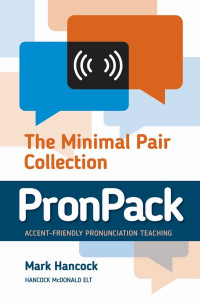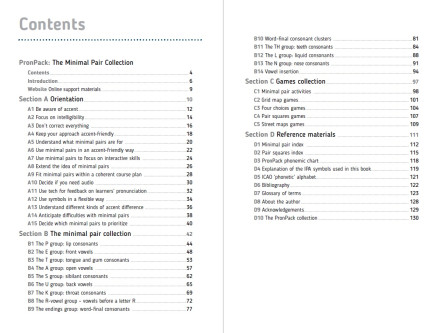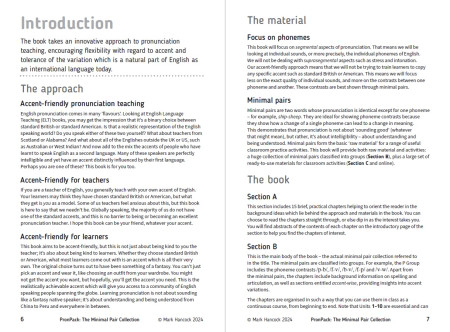PronPack: The Minimal Pair Collection

The Minimal Pair Collection provides teachers with a complete bank of ideas and material for focusing on English phonemes and phoneme contrasts. Rather than prescribing a single target model, the book takes a distinctive, ‘accent-friendly’ approach which recognises and accepts the varieties of English around the world today.
The main body of The Minimal Pair Collection consists of four sections. Section A is background reading, explaining the accent-friendly approach and key concepts in the book. Section B includes collections of minimal pairs gathered together in groups. Section C outlines the various game-types which can be used with the minimal pairs outlined in B. Section D is an extensive bank of resources and reference materials, including notes on the phonemic symbols used, an index of minimal pairs and lists of the materials available on the support website.
Section A contains 15 short chapters explaining the scope and approach of the book, why minimal pairs are so important in pronunciation teaching, and the practicalities of using minimal pairs in class. Reading this section straight through provides a complete overview. However, the tips are independent and self-contained so readers can also dip into them in any order they choose, as and when they feel the need.
Section B contains material about minimal pairs, gathered into 14 different groups. It includes notes about articulation and spelling, as well as innovative ‘accent-wise’ sections to help teachers decide which distinctions are essential for intelligibility and which are simply different accent alternatives.
Section C contains detailed teaching notes for five activity and game types which can be used with the minimal pair lists introduced in Section B. For each game, one example is given in the text, while extensive alternative versions are to be found on the support website. There's a collection of 50 downloadable 'Pair Square' images downloadable for free here: /materials/pair-squares-collection
Section D includes useful lists and indexes of the materials to be found in the book, notes about the phonemic symbols used, an extensive glossary of terms, and other reference material.
Food for thought
ACHIEVING GOALS
“You might not get the accent you want, but hopefully, you’ll get the accent you need.” (p.6)
PRONUNCIATION MODELS
“Perhaps we should worry less about models, and instead, offer successful examples.” (p.15)
LEARNERS OR USERS OF ENGLISH?
“At some point, we must stop treating people as learners and start accepting them as equal partners in the global English-speaking world. … When I ask for a coffee, I’m not asking for correction.” (p.16-17)
THE CAUSE OF MISUNDERSTANDINGS
“… in real-life interaction, the important question is not who is to blame; the important question is, ‘What must we do to make it right?” (p.25)
CORRECTING
“If the learner’s pronunciation of the phoneme is non-standard but clearly intelligibile, you can accept it. You can also give it in your own accent, but as an alternative rather than as a correction.” (p.35)
ACCENT-BIAS IN TECHNOLOGY
“The tech will understand standard native accents well, but often struggles with perfectly intelligible non-standard or non-native accents. … We have to understand that the tech is not always right. We need to treat it as fallible – like any human listener.” (p.32)
DEMONSTRATING FLEXIBILITY
“If you say word a, but the learners think you said word b, don’t tell them they are wrong. Instead, say, ‘Well, I wanted to say a, but maybe it wasn’t clear’ and try again. There’s nothing wrong with being a bit humble that way.” (p.25)






